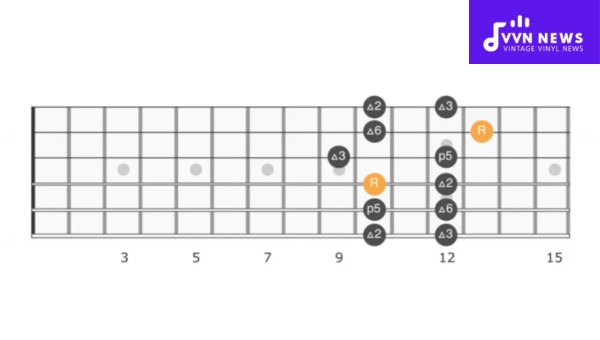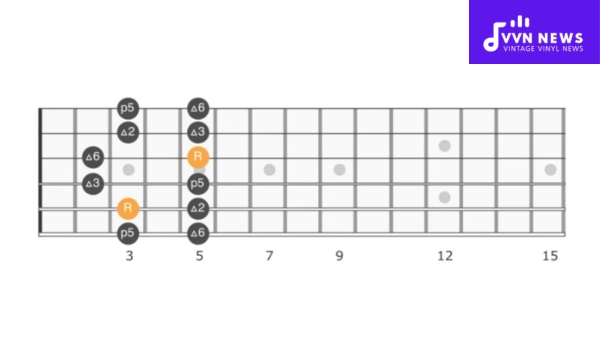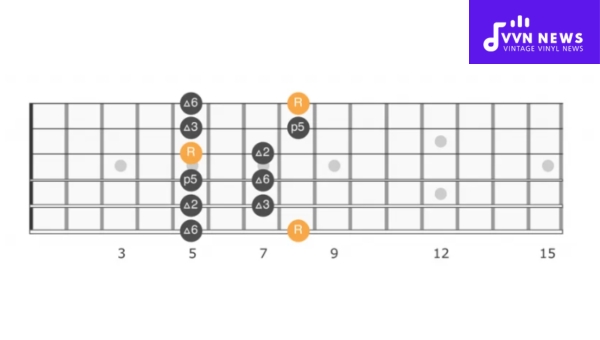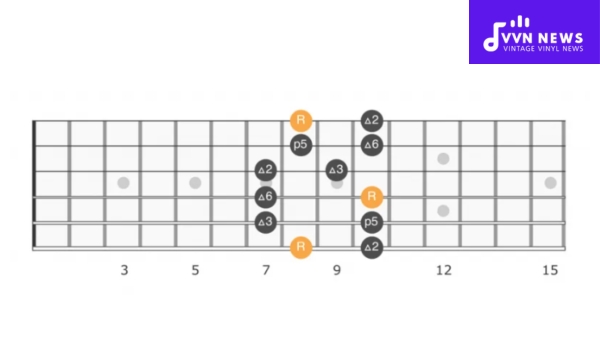As an individual interested in music, there’s an undeniable charm that draws us to the C major pentatonic scale. It is, after all, one of the most commonly used scales in the Western musical landscape and forms the backbone of countless memorable melodies and tunes that resonate within our souls.
The rich harmonies it creates are awe-inspiring and organic, and they have an uncanny ability to transport us across a broad spectrum of human emotion.
Let’s not forget that everything starts with understanding. Getting to know the C major pentatonic scale does more than just enhance our appreciation for melodies; it paves the way for us to delve into remarkable musical worlds we never knew existed.
If you’re curious about this captivating musical scale or want to deepen your knowledge about it, stick around as I untangle this musical marvel.
Basics of C Major Pentatonic Scale
The C Major Pentatonic Scale is a five-note musical scale, consisting of the notes C, D, E, G, and A. With C being the root note, it maps out a unique tonal layout on your instrument.
It’s often thought of as a ‘happy’ sounding scale, due to its major quality. Remember that ‘pentatonic’ means ‘five tones,’ hence only five distinct notes occur in every octave of this scale.
Each note represents a unique degree on the scale:
- First degree: C
- Second degree: D
- Third degree: E
- Fourth degree: G
- Fifth degree: A
Worth noting is that, unlike other major scales, the C major pentatonic devoids half-step intervals which typically provide tension in the music.
Also Read: Harmony In Music [Enhance Your Compositions With These Tips]
Creation of C Major Pentatonic Scale
The C Major Pentatonic scale emerges from the simplicity and elegance of five specific notes within the standard diatonic scale.

Constructing it requires selecting pitches that form a sequence both harmonious and sonorous.
Derived from the full C Major scale—comprised of seven different notes: C-D-E-F-G-A-B—by skipping certain intervals, we are left with its pentatonic counterpart.
Steps to Construct the Scale:
- Start with the Root: The foundation is the root note, C.
- Employ Whole Steps: Proceed by steps, jumping over one note: from C to D, skip E to land on F.
- Adopt Additional Pitches: Continue this pattern to collect A and G but omit B.
- Complete with Fifth Pitch: With your five distinct pitches—C-D-E-G-A—you’ve formed the scale.
The major pentatonic scale reflects a formula of whole steps and minor thirds; specifically—a W-W-m3-W-m3 pattern where ‘W’ signifies a whole step and ‘m3’ is a minor third interval.
From these core pitches, you can create inherently consonant melodies, as they avoid semitone clashes present in diatonic scales.
Indeed, the omission of half-steps—the F to E and B to C in standard tuning—gifts musicians a readily harmonious framework agile in various melodic contexts.
C Major Pentatonic Scale’s Five Shapes
The landscape of the C major pentatonic scale is defined by its five distinctive shapes on the fretboard.
Each shape offers a unique pathway through the scale, interlocking across the guitar neck to enable fluency and versatility in your playing.
Mastering these shapes can exponentially expand your improvisational and melodic prowess.
Shape 1 – The Home Box
This shape serves as the gateway for many into the world of pentatonic scales. Often referred to as “the home box,” it begins at the root note, C, on the third fret of the A string.
- Position: Start with your second finger on the root note.
- Patterns: You’ll play this familiar box pattern across two octaves, from C to C.
The simplicity of this shape makes it a primary choice for beginners to start experimenting with soloing and creating musical phrases.
Shape 2 – The Stretch
Next up is a shape that requires a bit more reach – hence “the stretch.” It starts on the fifth string from where Shape 1 left off.
- Position: Its anchor point lies with your fourth finger on G (3rd fret fifth string).
- Patterns: Involves a wider fingering pattern, which stretches across five frets in total.
This shape expands your tonal range and encourages positional shifting up the neck, essential for dynamic playing.
Shape 3 – Three Notes per String
Approaching our third configuration, we encounter a “three notes per string” format that starts on E (open sixth string).
- Position: Utilize all four fretting fingers for this elongated approach.
- Patterns: Consists mainly of horizontal movement along two adjacent strings at a time.
It’s greatly esteemed among shredders and allows rapid runs during solos while maintaining melodic integrity.
Shape 4 – The Horizontal Slide
In contrast to staying put in one position, Shape 4 emphasizes linear motion along single strings—The Horizontal Slide.
- Position: Commence from above octave C notes.
- Patterns: Transition seamlessly between positions with slides targeting pivot points within this extended landscape.
For expressive solo work, players exploit this layout to convey emotion through bends and vibratos within longer lines.
Shape 5 – High Octave Anchoring
Our final silhouette focuses on high octave notes that traverse upper regions of the fretboard—High Octave Anchoring.
- Position: Take flight starting typically from the C note on the tenth fret of the D string.
- Patterns: Cascade through high-pitched territories venturing beyond mid-neck space into spirited upper registers.
Your dexterity will be tested here as fingers dance over less familiar grounds endowed with sonic clarity.
When you’ve grasped these shapes firmly and maneuver through them fluidly, aural textures flourish in both lead and rhythm playing.
Embrace them to elevate melodies carved upon intricate canopies of harmonies crafted through skilled exploration.
Also Read: E Major: Scale And Chords [Exciting Sounds For Your Compositions]
Relative Major and Minor Pentatonic Scales
Discover the intrinsic link between relative major and minor pentatonic scales; they are like two sides of the same coin.

The C major pentatonic scale, for instance, shares its notes with the A minor pentatonic scale; A is known as the relative minor of C major.
They are intertwined harmonically, simply starting at different points in the same sequence of notes.
- C major pentatonic: C – D – E – G – A
- A minor pentatonic: A – C – D – E – G
This harmonious relationship allows musicians to shift seamlessly between emotions in a piece by altering their melodic focus without changing the fingering patterns on their instrument.
This concept is key when improvising or composing across various moods while maintaining a coherent tonal structure.
Using Backing Tracks for C Major Pentatonic Scale
When practicing the C Major Pentatonic Scale, incorporating backing tracks can be highly beneficial.
These accompaniments provide a fuller sound and context for your improvisation and help cement key musical concepts.
Enhance Your Timing and Rhythm
Perform along with a carefully selected backing track to sharpen your timing. The constant pulse of the track serves as a metronome, ensuring you stay on beat.
By playing the pentatonic patterns over different rhythm sections, you’ll develop a more robust sense of groove that is essential for any musician.
Develop Improvisational Skills
Utilizing backing tracks introduces an element of structure within which you can explore creatively. Let the chords guide your phrasing choices, allowing them to suggest passages or notes that would complement the rhythm section.
This is where you can let your fingers wander and find those golden moments that make solos stand out.
Explore Different Musical Styles
Backtracks come in various styles – from blues to jazz, to pop. Practicing these different genres broadens your musical vocabulary.
For example, a bluesy backing track might inspire you to bend notes and apply vibrato in ways a pop track wouldn’t.
Apply Music Theory Concepts
Engage with backing tracks as a practical application of music theory knowledge. Recognize chord progressions within the track and learn how they relate to the pentatonic scale shapes you are practicing.
Identify which notes create tension or resolution in soloing over particular chords – it’s like having an interactive theory lesson.
Experiment with Dynamics and Expression
Practicing dynamics – playing softly or loudly – lets you express yourself musically while ensuring your tone fits within the mix of the backing track. Varying your attack or using techniques such as legato or staccato gives life to otherwise simple pentatonic phrases.
Consistency reaps benefits when developing new skills on an instrument—a steady diet of varied and fun exercises bolsters motivation and skill alike.
Also Read: How To Transpose Bass Clef To Treble Clef [A How-To Guide]
Songs that Highlight the C Major Pentatonic Scale
When you hear a song that instantly lifts your mood or soothes your soul, there’s a fair chance the melody might be rooted in the sound of the C major pentatonic scale.

This scale’s simplicity often translates into clear, memorable tunes. Let’s look at five iconic songs, which showcase this scale’s versatility and timeless appeal.
“My Girl” – The Temptations
One of the most endearing examples of the C major pentatonic scale in action can be found in The Temptations’ classic “My Girl“.
The introductory riff played on a bass guitar with a smooth yet buoyant feel, encapsulates the sheer joy and affection inherent in the song’s lyrics.
Even if you’re unfamiliar with musical theory, you’ve likely hummed this melody without realizing its basis is in one of music’s most foundational scales.
“Amazing Grace” – Traditional
“Amazing Grace” is a traditional tune that has stood the test of time and translation across various genres.
This hymn embraces the pure tones of the C major pentatonic, offering clarity not only through its poignant words but also through its straightforward melody.
Whether it’s performed as a capella or accompanied by instruments, there’s no denying how flawlessly it demonstrates this scale’s power to evoke deep emotions.
“Brown Eyed Girl” – Van Morrison
Van Morrison’s “Brown Eyed Girl” begins with a jaunty guitar intro—the kind that immediately transports you to sunnier times.
Its use of the upbeat notes from the C major pentatonic gives it an infectious quality that has made it a staple on summer playlists everywhere.
“Shake It Off” – Taylor Swift
In more contemporary terms, Taylor Swift’s “Shake It Off” employs elements from our celebrated scale.
Particularly noticeable during her catchy choruses and bridges are those bright-sounding notes typical for this pentatonic pattern, making for an exuberant anthem about resilience and positivity.
“Louie Louie” – The Kingsmen
Lastly, let’s talk about “Louie Louie” by The Kingsmen—a surefire way to break down how instrumental patterns drawn from C major pentatonic can form an unforgettable hit.
The simplistic chord progression buoyed by this melodic structure creates an earworm that has surely echoed through each listener’s head long after they’ve heard it.
Each one of these songs stands as proof not just of great songwriting but also showcases how fundamental and versatile the C major pentatonic can be.
Its simplicity allows artists to craft tunes that reach an array of listeners regardless of their musical background—inviting everyone to bask in melodiousness in its purest form.
Also Read: How To Transpose Into The Tenor Clef? [Mastering In Notation]
FAQs
What are the notes in the C Major Pentatonic Scale?
The C Major Pentatonic Scale consists of five notes: C, D, E, G, and A.
Can I play the C Major Pentatonic Scale on any instrument?
Yes, you can play the C Major Pentatonic Scale on virtually any tuned musical instrument.
Is the C Major Pentatonic Scale suitable for beginners?
Absolutely, this scale is considered one of the easiest and most user-friendly for beginners to learn and practice.
How does the C Major Pentatonic differ from the standard major scale?
The C Major Pentatonic scale is a simplified version, omitting the fourth and seventh notes (F and B) from the standard C major scale.
Are there common chord progressions that work well with the C Major Pentatonic Scale?
Yes, try chord progressions like I-IV-V (C-F-G) or I-ii-IV (C-Dm-F), which complement the pentatonic melodies beautifully.
Also Read: How To Transpose Bass Clef To Treble Clef [A How-To Guide]
Conclusion
The C major pentatonic scale is a beautiful and versatile tool in your musical arsenal. Its simplicity offers a gateway to effortless improvisation and songwriting.
If you’re a guitar whiz, an eager pianist, or just fond of humming along, mastering this scale enriches your melodies with that quintessential, joyous character.
Harness the scale’s charm, experiment with its five distinct shapes, and expand your creative horizons.








